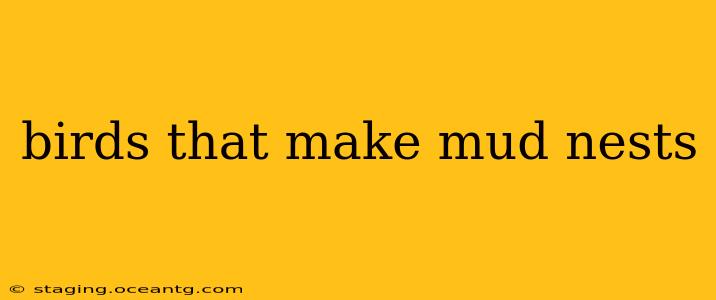Many bird species utilize mud as a key component in their nest construction, showcasing remarkable architectural skills and ingenuity. This intricate process results in diverse nest structures, each adapted to the species' specific needs and environment. Let's explore the fascinating world of mud nest builders and delve into the intricacies of their construction techniques.
What Kinds of Birds Build Mud Nests?
A wide variety of bird species incorporate mud into their nests, from tiny swallows to larger, more robust birds. The type of mud nest varies greatly depending on the species. Some common examples include:
-
Swallows (Hirundinidae): Various swallow species, known for their aerial acrobatics, are renowned for their mud nests. These nests are often cup-shaped, attached to cliffs, bridges, or even the eaves of buildings. The mud is mixed with saliva and other materials like twigs and grass to provide structural integrity.
-
Ovenbirds (Furnariidae): These South American birds are masters of mud architecture, crafting elaborate, oven-like nests that can be quite substantial. These nests often feature a domed structure with a side entrance, offering excellent protection from predators and the elements.
-
Hornbills (Bucerotidae): Certain hornbill species build nests utilizing mud as a key component. The specific construction techniques and the extent of mud usage can vary among different hornbill species.
-
Ibises (Threskiornithidae): Some ibis species incorporate mud into their nest structures, often building them in colonies.
-
Other species: Several other bird species, including some species of wrens, flycatchers, and warblers, also use mud to varying degrees in their nest construction.
Why Do Birds Use Mud for Their Nests?
The use of mud in nest building offers several significant advantages:
-
Strength and Stability: Mud provides exceptional structural strength and stability, enabling the construction of durable nests that can withstand harsh weather conditions and potential damage from predators.
-
Protection from Predators: The sturdy nature of mud nests offers excellent protection against predators, shielding the eggs and chicks from harm. The location of the nest, often tucked away in crevices or high up, further enhances protection.
-
Camouflage: The color and texture of mud can provide effective camouflage, making the nest less visible to predators.
-
Insulation: Mud can help regulate the temperature inside the nest, providing insulation against both heat and cold.
How Do Birds Build Mud Nests?
The construction process varies depending on the species but generally involves:
-
Gathering Materials: Birds collect mud from various sources, such as riverbanks, puddles, or wet soil.
-
Mixing and Shaping: The mud is often mixed with saliva or other organic materials to create a workable consistency. They then shape the mud into the desired form using their beaks and feet.
-
Adding Reinforcement: Twigs, grass, feathers, and other materials are often incorporated into the mud structure to provide additional strength and stability.
-
Drying and Hardening: The mud nest is left to dry and harden, which can take several days or even weeks.
What are some common materials used besides mud?
Besides mud, birds often incorporate a variety of other materials into their nests, depending on availability and species-specific preferences. These materials can include:
- Twigs and sticks: Provide structural support and framework.
- Grass and leaves: Offer insulation and cushioning.
- Animal hair and feathers: Add warmth and softness.
- Saliva: Acts as a binder, helping to hold the mud and other materials together.
- Other natural debris: Depending on the species and environment, other materials such as bark, spider silk, or even plastic might be used.
How long does it take to build a mud nest?
The time required to build a mud nest varies significantly across species and factors like weather and material availability. It can range from a few days to several weeks. Some species build nests collaboratively, accelerating the process.
Do all mud nests look the same?
Absolutely not! The appearance of a mud nest varies dramatically depending on the bird species. Some are simple, cup-shaped structures, while others are elaborate, dome-shaped creations. The size, shape, and location of the nest are all species-specific adaptations reflecting their particular needs and habitats.
This exploration of birds and their mud nests highlights the incredible diversity and ingenuity found in the avian world. Their architectural skills and adaptations are a testament to the power of natural selection and the remarkable abilities of these creatures.
